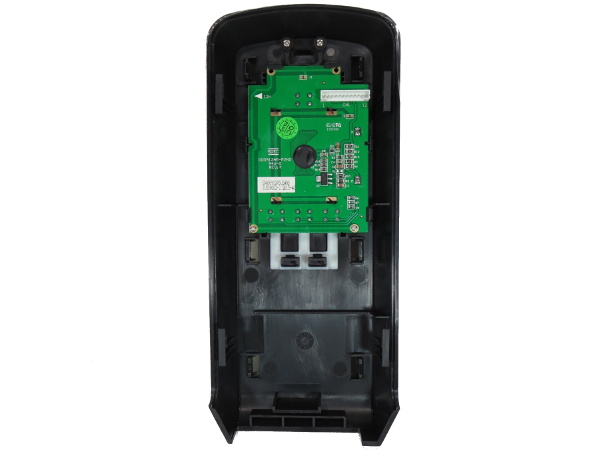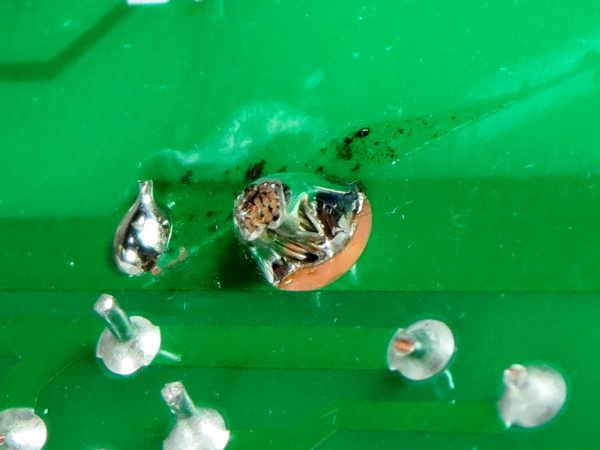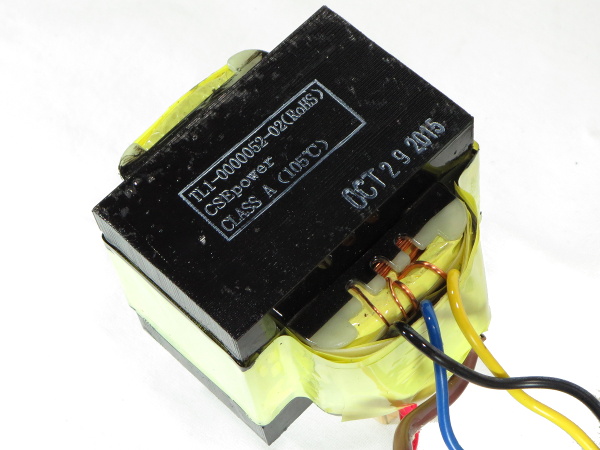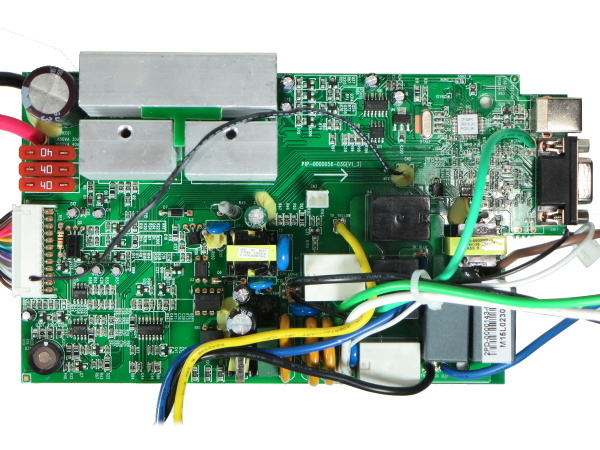CyberPower CP1000PFCLCD Tear-Down
Behind The Front Cover
Here is the front cover. Along the left and right sides, you can see four hooks that slot into the side panels to hold them together. From this angle, they look like slots themselves. Further inside but still parallel to the sides are two columns of translucent gray-brown plastic holding the glossy face panel in place. The bottom edge features three key holes for the battery door’s two tabs to slot into. In the top half, you find the LCD and control module, which has a simple chip-on-board (CoB) device.
Behind The Rear Panel
It looks like the 1000PFCLCD uses the same coax surge protection as the LX1500. Also similar is the lack of a common-mode choke between the cord and protection-only outlets; the protection is downstream from those outlets instead of upstream.
The phone/network surge protection board is different. It also has the wiring fault indicator circuit on it, along with a header to receive a cable from the motherboard providing access to live and neutral (the thin black and white wires in the bottom-left) required by the wiring fault indicator function.
Downsizing
While the cord uses #14 conductors, everything beyond the “protection-only” outlets is #16, which should be fine as long as the site wiring is correct (no live-neutral inversion), the UPS’ own current limiting on the battery backup outlets is working correctly and there is no fault on the motherboard causing it to draw grossly abnormal current without tripping a breaker.
Strips
We find the same pinchy fingers for live and neutral as the LX1500, and the same torque bar ground connections as well. Soldery-weldy joints between the wires and strips look a little dodgy though.
Crushed
Wires were attached to the strips using spot-welding. An electrode compresses the tinned wires’ strands together, then current gets passed through the strip and strands to fuse them together. Here though, the electrode appears to have had a sharp edge that partially gouged its way through the strands along the upper strip edge. In a high-vibration environment, this could cause premature mechanical failure. It could also cause slight hot-spotting under high electrical load, though the strips should provide enough heat-sinking to prevent it from becoming a real concern.
Network Surge Suppression
The layout may be different, but a quick glance at the number of diodes around the RJ45 connectors quickly points towards a similar if not identical circuit as the LX1500’s. If I wanted to be optimist, I’d guess that the messy design was an attempt to keep signal pairs together. But a quick glimpse at the bottom layer shows that some signal pairs are not even routed on the same layer. The layout change was mainly about reducing board footprint.
Get Tom's Hardware's best news and in-depth reviews, straight to your inbox.
Quick And Dirty
Whoever manually soldered the ground wire to the circuit board was in a hurry, slipped, scratched the solder mask, did not apply enough heat for the solder to wick through the strands, and we get a joint that looks like the solder tented over the strands instead of forming a uniform solid joint around the whole wire and pad. The wave-soldered joints, on the other hand, look great.
Not A Fan Of The Fan
Sitting just above the transformer on a small bracket is a 40mm fan that kicks on immediately whenever the UPS switches to battery power and remains on for a few minutes after AC power is restored. With no ducting guiding airflow around the transformer or preventing it from recirculating through the fan, I was really surprised to actually feel a noticeable breeze coming out from the top vents.
And yes, this little screamer is no exception to the “small fans are loud” generalization. Considering that the motherboard has a thermistor going behind the transformer, I was surprised that CP does not at least wait for the transformer to warm up a little before turning on the fan at full speed.
Transformer
Instead of having a center-tapped winding on the low voltage side and operating the inverter by alternately driving one half, the 1000PFCLCD uses a full bridge driver, which allows it to use only one winding there. On the high voltage side, I suspect that the AVR primary is the thin wire connected to black and blue doubling as the inverter’s output winding, which may explain why a fan is needed. CP used the absolute minimum wire gauge necessary to provide the 8A of backup power the UPS is rated for (0.9mm including the enamel coating, which means #20 gauge) and may get warm very quickly under heavy load. The buck/boost winding, on the other hand, is 1.5mm thick including the enamel, which puts it about half-way between #15 and #16.
The Main Course
Can you spot the biggest difference between this board and every other UPS I have opened in the past eight months? It has three heat sinks in its inverter circuit instead of two. The two half-width sinks provide the low-side drivers and double as transformer cable terminal blocks, while the wide one hosts the high-side drivers. A small piece of T-shaped scrap PCB inserted between fins acts as a spacer to prevent short circuits between heat sinks.
The other area of interest is the bottom-right corner where all the relays, surge protection and filtering occur.
MORE: APC BE550G Tear-Down
MORE: Tripp-Lite SMART1000LCD Tear-Down
MORE: CyberPower LX1500GU-FC UPS Tear-Down
-
KaiserPhantasma inally =D but will these get a "ok to buy" from you or are there other models/brands we can look at?Reply
also well written nice job on the article -
Daniel Sauvageau Aside from Tripp-Lite which gets a definitive fail for lacking a breaker and wasting twice as much power as almost any other UPS I have taken apart here, they are all "worth looking at" if they suit your specific application.Reply
I'm using the LX1500 for my main PC (not using the coax nor Ethernet protections), I installed the BE550 at my mother's place as planned and I'm currently using the 1000PFCLCD as a portable/isolated AC source.
None of them are perfect but they are all usable. There is that nagging feeling from seeing third or fourth tier caps peppered throughout most of them. Higher quality caps appear to have gone extinct in UPS under ~$160. At least those I have gotten my hands on so far. -
cage0022 I enjoy your reviews, but this was so technical, I'm not even sure if this is a positive review or not. So are you saying it doesn't really do sine wave and if buying for that factor, it's a waste of money?Reply
Lastly, what would you recommend for someone who wants a good sinewave UPS that also offers good surge protection, without breaking the bank? (or, what's the most affordable way to get a good surge protector and battery backup unit?) -
Daniel Sauvageau Reply
It is a tear down, I show you what is inside, comment on some of the things I have seen and readers can decide if what they have seen is worth whatever the unit or an equivalent one might be worth to them. The PFCLCD did produce a (mostly) sinusoidal output but on my unit, the output voltage under no-load condition was intermittently extremely low the first few times I checked. An UPS would not normally run under no-load condition, so that shouldn't be an issue during normal use.18256861 said:I enjoy your reviews, but this was so technical, I'm not even sure if this is a positive review or not.
Where surge protection in UPSes is concerned, none of those I have looked at here so far have anything beyond basic three MOVs surge protection on the power side, the same protection found in the same brands' $10-15 power strips. If you want more thorough power line surge protection, you will need to disregard the UPS and surge protector instructions and use something else with more serious surge protection (isobar, SurgeArrest Performance, SurgeX/Zerosurge, etc.) upstream from the UPS.
-
falchard Actually for a Coax cable you want the dielectric just a bit past the fitting's edge. Depending on how cheap the fitting is, it may need to be a little longer. Still that coax cable is junk and running a coax through the UPS will probably ruin a digital signal. Better to ground out a coax cable at the MPOE instead of through a surge protector.Reply -
cage0022 Reply18258292 said:18256861 said:I enjoy your reviews, but this was so technical, I'm not even sure if this is a positive review or not.
If you want more thorough power line surge protection, you will need to disregard the UPS and surge protector instructions and use something else with more serious surge protection (isobar, SurgeArrest Performance, SurgeX/Zerosurge, etc.) upstream from the UPS.
Thank you for the clarification on the sinewave issue. Where you state, "disregard the UPS and surge protector instructions and use something else with more serious surge protection (isobar, SurgeArrest Performance, SurgeX/Zerosurge, etc.) upstream from the UPS", is that safe to do? I thought I'd read somewhere that you shouldn't plug a UPS into a surge protector (or vise versa). If so, that's what's lead to my quandary - if you shouldn't plug a UPS into a surge protector, then how does when get surge and battery backup?
Also, thank you for the teardowns - although I may not understand the technical side, it's still a great read and good to see someone separating the marketing from the truth.
-
Daniel Sauvageau Reply
Indications against it are stuck on labels, printed or molded into just about every UPS and power strip I have taken apart here. There are two reasons I can think of: not overloading the power bar (which you shouldn't be able to do on a good bar with #14 cord and a 15A breaker in the first place) and poor/intermittent ground connections on those cheap bars or UPS that use simple flaps for the ground connections like the BE550 from last month.18259735 said:is that safe to do? I thought I'd read somewhere that you shouldn't plug a UPS into a surge protector (or vise versa).
Of those two issues, I'd say poor ground is the one that bothers me the most as those square-bent flap-style ground connections are still common despite the more reliable torque contact style (I call them 'torque' because the contact fingers attach to the sides of the metal strips which act as torque bars and reduce strain at bend lines) costing practically the same to manufacture: one slightly more complex cutting die, one slightly more complex bending/shaping die, same amount of metal. (Though based on the level of inconsistency in how flaps get bent, I would not be surprised if they got 'shaped' by poking blunt nails in assembled units instead of a die.)
Every extra cord and junction box between the breaker box and your loads is one more potential point of failure and extra power losses. There is nothing fundamentally wrong with combining devices within reason but manufacturers don't want to take the blame if people exaggerate and something goes wrong.
I believe the only power bar I have seen that lacked such instructions is the SurgeX's SA-1810. That thing is built like a tank, which does not leave much for the company to worry about. I would expect no less from a $200+ surge protector and its instructions even suggest protecting UPSes as one application. -
gamebrigada I would love to see you tear down some "Enterprise" grade UPS's. Some that have some serious reliability and where name brands are paid extra for. I would do one myself out of curiosity but I doubt my opinion would be regarded well.Reply -
jeyman Dan,Reply
I wanted to say that your review is very thorough and well put together. I gained a lot of insight about the Cyberpower units and how they are built (as well as their shortcomings). Thank you for that.
A few things to consider though. Your writing style sometimes comes across as overly sarcastic and you make a presumption that the reader has already gone through your previous articles, leaving off key details or making inferences. Additionally, your readers could benefit from a well formed summary or conclusion as we do not all possess the skill sets that you do. With your attention to detail and obvious subject knowledge, I think your articles could be made even better with a little more time and care.
I look forward to seeing many more of your articles and will make a point to check out your previous postings.
Thanks again for the good read.









